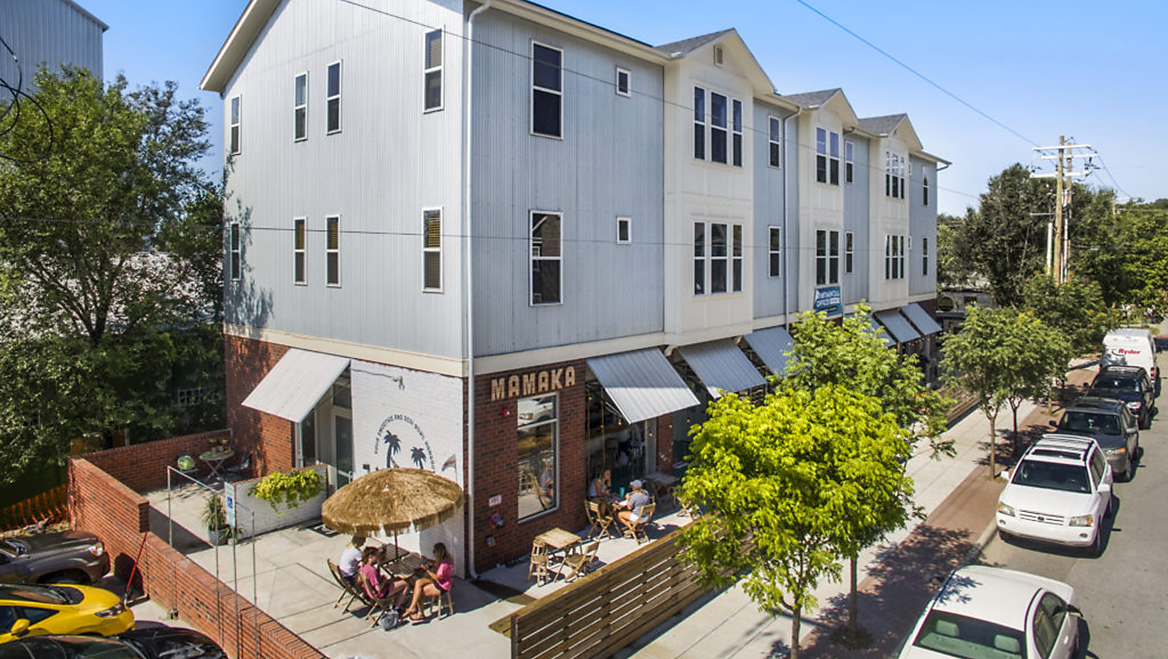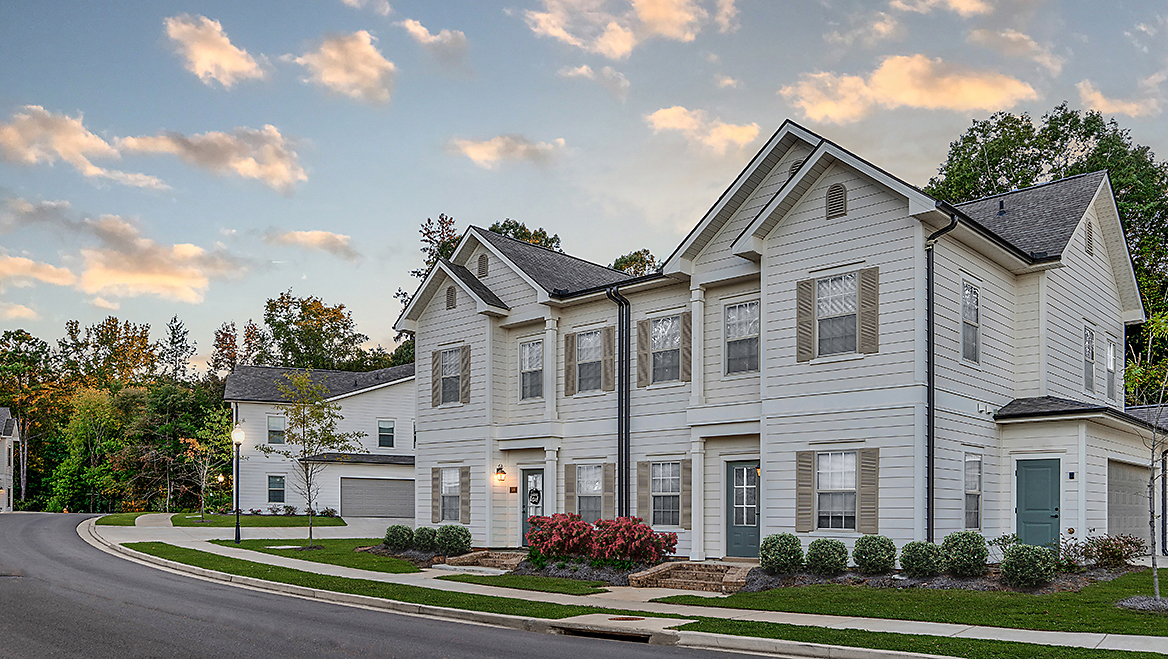March 9, 2023
Economic dynamism, the lifeblood of cities and small towns, comes in many forms: workplace mobility enabling talent to thrive and find new opportunities, investments in public infrastructure and education, the incubation of small businesses and entrepreneurs. In most cases, this starts with the space or places to build retail and housing — and experiment.
Zoning reform, which can unlock new opportunities and new spaces to build affordable homes and small businesses, can be a key part of this shift.
In a number of smaller and midsize cities, changes to regulations meant to boost development have realized the potential of parking lots and underused commercial structures with a big impact on the vitality and success of their downtowns — especially during the current uncertainty around remote work and larger economic shifts.

Eliminating parking minimums in 2015 catalyzed economic development in Fayetteville, Arkansas. Here, a vacant lot was transformed into a mixed-use building with nine apartments, two offices, a smoothie bar, and a taproom. Photo courtesy of Specialized Real Estate Group.
Fewer parking requirements, more small businesses
Take Fayetteville, Arkansas, which eliminated parking minimums in 2015. The change hasn't been a radical shift as much as a realization of new development opportunities. Local developers kept asking to redevelop abandoned or underused properties, but once they encountered the parking requirements and other red tape standing in the way, they often backed away from an uphill battle, says Matthew Petty, a planner, founder and principal of the Infill Group, and faculty member of the Incremental Development Alliance.
"The lack of convenience is the barrier," says Petty. For him, the real change happened when leadership saw an opportunity and followed the majority's inclination to try a new way. "You have to have leaders who are willing to take action, who are willing to stop the cycle of getting more and more information and trying to achieve total consensus."
The lack of a story around the policy shift became the story. There was no fierce backlash, no business horror stories, no examples of the change constricting opportunity. The elimination of parking minimums proved there simply wasn't much justification for the regulations in the first place.
The result, a new approach to development and a handful of projects that rely on street and other existing parking instead of on-site spots, shows how creative zoning can literally open the door to a new small business. A vacant building that sat empty for decades because it only offered a handful of parking spots found new life when the new rules allowed a restaurateur to take a chance on the space, creating the highly touted Feed & Folly restaurant and rooftop bar.
In another section of downtown, Petty's Infill Group was able to transform an old commercial space into a three-story, mixed-use retail and residential tower with 495 Prairie, a craft beer bar. This project type would have been impossible if saddled with onerous parking requirements. Currently, a 130-room hotel project is winding its way through council, only able to pencil out due to reliance on existing street parking.
Now, business owners can put people over parking by focusing on serving their customers, Petty says, instead of taking on the stress of also being compliance officers.
A new zoning district for gentle density
In Lexington, Kentucky, planners pushed a series of reforms in 2018 as a means of bolstering businesses, including eliminating minimum parking requirements and allowing retail and multifamily by-right in specific commercial areas. According to Chris Taylor, principal planner of long-range planning for the Lexington-Fayette Urban County Government, part of the push for change is growth boundaries: the area's famous horse farms form a natural barrier to expansion — and sprawl. This limit adds pressure to densify and encourage better use of space.
Part of the solution outlined in the county's 2018 reforms was a change to what's known as B6-P zoning, also called a "Planned Shopping Center." Adjusting rules so these aging — and, in many cases, obsolete — retail spots on commercial corridors could shed excess parking and be transformed into new retail and residential concepts opened up opportunity. Planners could mandate by-right residential development, with no height limit, with virtually none of the opposition that happens when upzoning within existing residential areas.
"To us, it was the ultimate win, because we created literally millions of square feet for residential development without having to touch any residential zones," said Taylor. "If you're in our seats, and you're trying to find places where you can just accommodate growth, you've got to take the easy wins where you can get them, because everything else is a dogfight."
One of the most important outcomes of this change was the realization of incrementalism, Taylor says. Contrary to the fears of many opponents, the shift didn't create a frenzy of haphazard building. Instead, it meant gentle density, a return to missing middle housing, additional opportunities, and the ability of developers to tweak existing plans and projects to accommodate, say, more residential units or affordable housing.
Plus, as planners pursued what they called more responsive parking requirements in 2021, commercial developers began experimenting with smaller infill projects, using parking lots for experiential programming and events.
"You could see the immediate tradeoff of parking for affordable units," says Taylor. "It was really helpful for us being able to get support, to just prove that it wasn't going to be as shocking and revolutionary as some feared."

Zoning reform in the college town of Oxford, Mississippi, has focused in part on providing housing affordable to more income levels. A new bedroom-per-acre measure helped encourage more density, paving the way for workforce housing like the Belle Rivers, a new Section 42 development. Photo courtesy of Belle Rivers.
Incentivizing workforce and affordable housing
Commercial development isn't the only way to spur commercial activity. In Oxford, Mississippi — a bucolic college town with a population and workforce that ebbs and flows with the school year and Southeastern Conference football games — zoning changes and a new comprehensive plan focused on increasing housing production have brought more activity and shoppers to downtown stores.
These efforts started in 2017, with the city leveraging a new, increased bedroom-per-acre measure to help encourage more density; an incentive ordinance for affordable housing was also passed. These efforts spurred increased production of much-needed workforce housing, including four Section 42 housing developments near trails, greenspaces, grocery, and other retail. Now, the residents who staff businesses clustered around the city's historic town square have more places to live and thrive.
"We're starting to see more density that's applied in new developments that provide more options and opportunities for not only our student population, but also older populations," says Benjamin Requet, AICP, Oxford's director of planning. "Even young families are moving to our community for the good schools, the transportation options, and just the wonderful quality of life that our community is able to offer."
For Requet and others, the reforms and expanded development opportunities aren't just about increasing the housing supply or adding a few new businesses. It's about creating and shaping a more exciting, vibrant, and welcoming community.
"What's at stake is the lack of options and type of communities that we desire in places like Oxford, Mississippi," Requet says.




